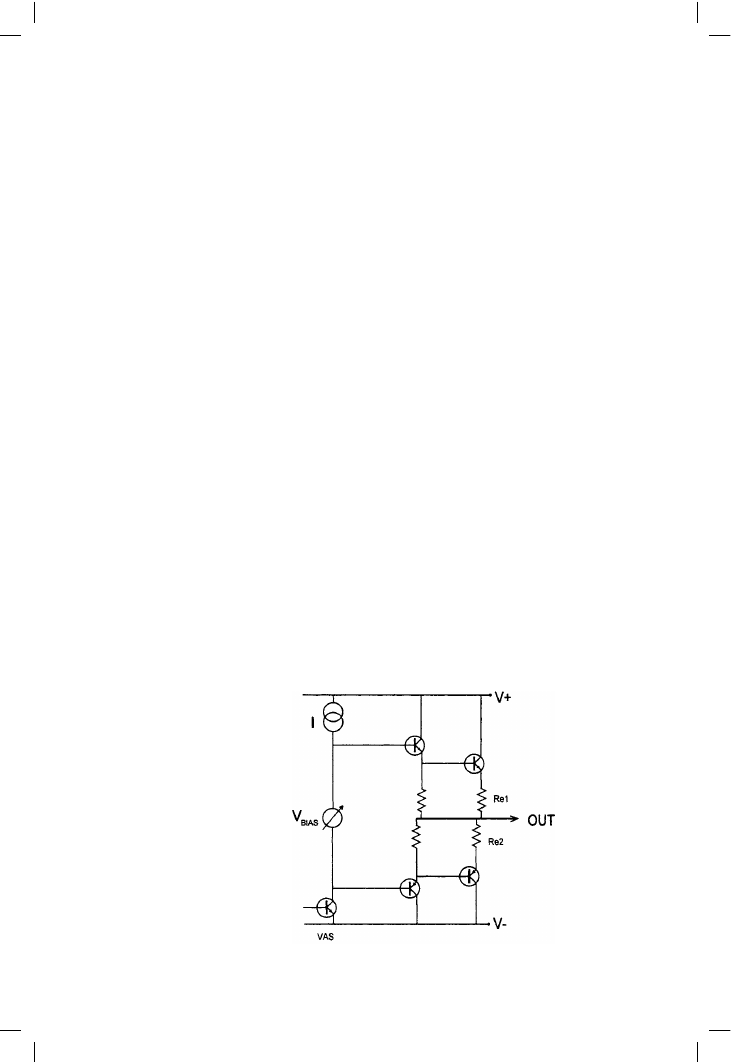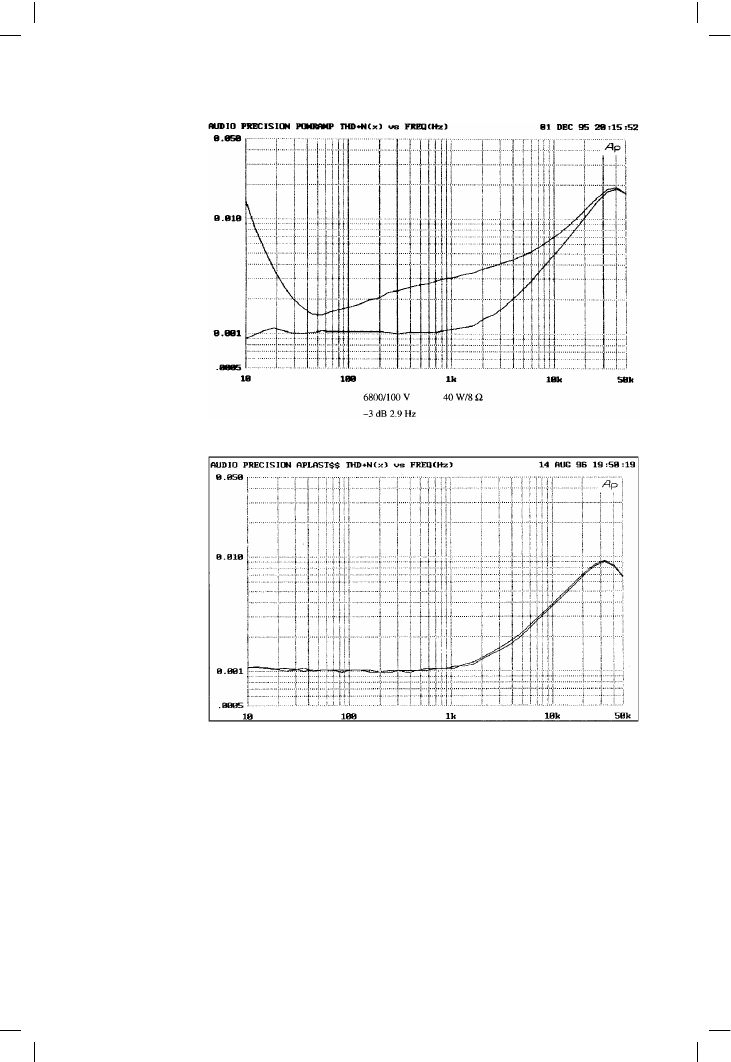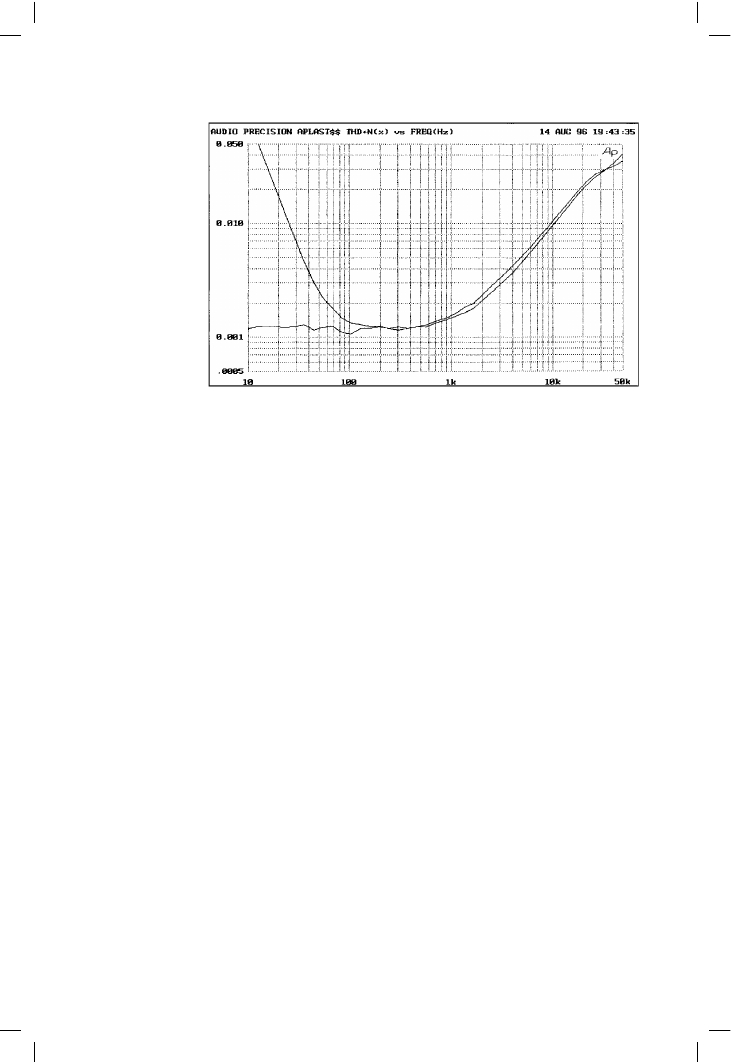ВУЗ: Казахская Национальная Академия Искусств им. Т. Жургенова
Категория: Учебное пособие
Дисциплина: Не указана
Добавлен: 03.02.2019
Просмотров: 17361
Скачиваний: 18

Audio Power Amplifier Design Handbook
designed so that a minimum idling current can be separately set up in each
output device. However, to the best of my knowledge this approach has not
yet achieved commercial exploitation.
Geometric mean Class-AB
The classical explanations of Class-B operation assume that there is a fairly
sharp transfer of control of the output voltage between the two output
devices, stemming from an equally abrupt switch in conduction from one
to the other. In practical audio amplifier stages this is indeed the case, but
it is not an inescapable result of the basic principle. Figure 2.5 shows a
conventional output stage, with emitter resistors Re1, Re2 included to
increase quiescent-current stability and allow current-sensing for overload
protection; it is these emitter resistances that to a large extent make classical
Class-B what it is.
However, if the emitter resistors are omitted, and the stage biased with two
matched diode junctions, then the diode and transistor junctions form a
translinear loop
[21]
around which the junction voltages sum to zero. This
links the two output transistor currents I
p
, I
n
in the relationship I
n
*I
p
=
constant, which in op-amp practice is known as Geometric-Mean Class AB
operation. This gives smoother changes in device current at the crossover
point, but this does not necessarily mean lower THD. Such techniques are
not very practical for discrete power amplifiers; firstly, in the absence of the
very tight thermal coupling between the four junctions that exists in an IC,
the quiescent-current stability will be atrocious, with thermal runaway and
spontaneous combustion a near-certainty. Secondly, the output device bulk
emitter resistance will probably give enough voltage drop to turn the other
device off anyway, when current flows. The need for drivers, with their
extra junction-drops, also complicates things.
40
Figure 2.5
A conventional double
emitter-follower output
stage with emitter
resistors Re shown

History, architecture and negative feedback
A new extension of this technique is to redesign the translinear loop so that
1/I
n
+ 1/I
p
= constant, this being known as Harmonic-Mean AB opera-
tion
[22]
. It is too early to say whether this technique (assuming it can be
made to work outside an IC) will be of use in reducing crossover distortion
and thus improving amplifier performance.
Nested differentiating feedback loops
This is a most ingenious, but conceptually complex technique for
significantly increasing the amount of NFB that can be applied to an
amplifier. See Cherry
[23]
.
AC and DC coupled amplifiers
All power amplifiers are either AC-coupled or DC-coupled. The first kind
have a single supply rail, with the output biased to be halfway between this
rail and ground to give the maximum symmetrical voltage swing; a large
DC-blocking capacitor is therefore used in series with the output. The
second kind have positive and negative supply rails, and the output is
biased to be at zero volts, so no output DC-blocking is required in normal
operation.
The advantages of AC-coupling
1 The output DC offset is always zero (unless the output capacitor is
leaky).
2 It is very simple to prevent turn-on thump by purely electronic means. The
amplifier output must rise up to half the supply voltage at turn-on, but
providing this occurs slowly there is no audible transient. Note that in
many designs, this is not simply a matter of making the input bias voltage
rise slowly, as it also takes time for the DC feedback to establish itself, and
it tends to do this with a snap-action when a threshold is reached.
3 No protection against DC faults is required, providing the output
capacitor is voltage-rated to withstand the full supply rail. A DC-coupled
amplifier requires an expensive and possibly unreliable output relay for
dependable speaker protection.
4 The amplifier should be more easy to make short-circuit proof, as the
output capacitor limits the amount of electric charge that can be
transferred each cycle, no matter how low the load impedance. This is
speculative; I have no data as to how much it really helps in practice.
5 AC-coupled amplifiers do not in general appear to require output
inductors for stability. Large electrolytics have significant equivalent
series resistance (ESR) and a little series inductance. For typical amplifier
output sizes the ESR will be of the order of 100 m!; this resistance is
probably the reason why AC-coupled amplifiers rarely had output
inductors, as it is enough resistance to provide isolation from capacita-
41

Audio Power Amplifier Design Handbook
tive loading and so gives stability. Capacitor series inductance is very low
and probably irrelevant, being quoted by one manufacturer as ‘A few
tens of nanoHenrys’. The output capacitor was often condemned in the
past for reducing the low-frequency damping factor (DF), for its ESR
alone is usually enough to limit the DF to 80 or so. As explained above,
this is not a technical problem because ‘damping factor’ means virtually
nothing.
The advantages of DC-coupling
1 No large and expensive DC-blocking capacitor is required. On the other
hand the dual supply will need at least one more equally expensive
reservoir capacitor, and a few extra components such as fuses.
2 In principle there should be no turn-on thump, as the symmetrical supply
rails mean the output voltage does not have to move through half the
supply voltage to reach its bias point – it can just stay where it is. In
practice the various filtering time-constants used to keep the bias
voltages free from ripple are likely to make various sections of the
amplifier turn on at different times, and the resulting thump can be
substantial. This can be dealt with almost for free, when a protection
relay is fitted, by delaying the relay pull-in until any transients are over.
The delay required is usually less than a second.
3 Audio is a field where almost any technical eccentricity is permissible, so
it is remarkable that AC-coupling appears to be the one technique that is
widely regarded as unfashionable and unacceptable. DC-coupling
avoids any marketing difficulties.
4 Some potential customers will be convinced that DC-coupled amplifiers
give better speaker damping due to the absence of the output capacitor
impedance. They will be wrong, as explained on page 25, but this
misconception has lasted at least forty years and shows no sign of fading
away.
5 Distortion generated by an output capacitor is avoided. This is a serious
problem, as it is not confined to low frequencies, as is the case in small-
signal circuitry. See page 173. For a 6800 µF output capacitor driving
40 W into an 8 ! load, there is significant mid-band third harmonic
distortion at .0025%, as shown in Figure 2.6. This is at least five times
more than the amplifier generates in this part of the frequency range. In
addition, the THD rise at the LF end is much steeper than in the small-
signal case, for reasons that are not yet clear. There are two cures for
output capacitor distortion. The straightforward approach uses a huge
output capacitor, far larger in value than required for a good low-
frequency response. A 100,000 µF/40 V Aerovox from BHC eliminated
all distortion, as shown in Figure 2.7. An allegedly ‘audiophile’ capacitor
gives some interesting results; a Cerafine Supercap of only moderate size
(4700 µF/63 V) gave Figure 2.8, where the mid-band distortion is gone,
but the LF distortion rise remains. What special audio properties this
42

History, architecture and negative feedback
component is supposed to have are unknown; as far as I know
electrolytics are never advertised as ‘low mid-band THD’, but that seems
to be the case here. The volume of the capacitor case is about twice as
great as conventional electrolytics of the same value, so it is possible the
crucial difference may be a thicker dielectric film than is usual for this
voltage rating.
Either of these special capacitors costs more than the rest of the amplifier
electronics put together. Their physical size is large. A DC-coupled
amplifier with protective output relay will be a more economical option.
43
Figure 2.6
The extra distortion
generated by an
6800 µF electrolytic
delivering 40 W into
8 !. Distortion rises
as frequency falls, as
for the small-signal
case, but at this
current level there is
also added distortion
in the mid-band
Figure 2.7
Distortion with and
without a very large
output capacitor, the
BHC Aerovox
100,000 µF/40 V
(40 watts/8!).
Capacitor distortion is
eliminated

Audio Power Amplifier Design Handbook
A little-known complication with output capacitors is that their series
reactance increases the power dissipation in the output stage at low
frequencies. This is counter-intuitive as it would seem that any
impedance added in series must reduce the current drawn and hence the
power dissipation. In fact it is the load phase shift that increases the
amplifier dissipation.
6 The supply currents can be kept out of the ground system. A single-rail
AC amplifier has half-wave Class-B currents flowing in the 0 V rail, and
these can have a serious effect on distortion and crosstalk
performance.
44
Figure 2.8
Distortion with and
without an
‘audiophile’ Cerafine
4700 uF/63 V
capacitor. Mid-band
distortion is eliminated
but LF rise is much the
same as the standard
electrolytic
Negative feedback in power amplifiers
It is not the role of this book to step through elementary theory which can
be easily found in any number of textbooks. However, correspondence in
audio and technical journals shows that considerable confusion exists on
negative feedback as applied to power amplifiers; perhaps there is
something inherently mysterious in a process that improves almost all
performance parameters simply by feeding part of the output back to the
input, but inflicts dire instability problems if used to excess. I therefore deal
with a few of the less obvious points here; much more information is
provided in Chapter 7.
The main use of NFB in amplifiers is the reduction of harmonic distortion,
the reduction of output impedance, and the enhancement of supply-rail
rejection. There are analogous improvements in frequency response and
gain stability, and reductions in DC drift, but these are usually less
important in audio applications.